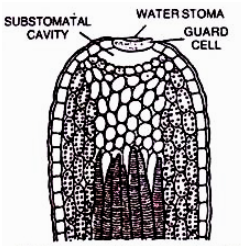When we peel the skin of a potato tuber, we remove
1. Periderm
2. Epidermis
3. Cuticle
4. Sapwood
1. Periderm
2. Epidermis
3. Cuticle
4. Sapwood
A vessel less piece of stem possessing prominent sieve tubes would belong to
1. Pines
2. Eucalyptus
3. Grass
4. Trachodendron
Consider the given two statements:
| I: | Parenchyma cells in plants play an important role in regeneration and wound healing. |
| II: | They are living at maturity and usually have only primary walls. |
1. Both I and II are correct and II explains I
2. Both I and II are correct but II does not explain I
3. I is True but II is False
4. Both I and II are False
In the given diagram of the root apical meristem, what would be true for the structure labeled as number 1?
1. The cells in the region continually divide to produce cells of region 5
2. The cells in this region divide at much faster rate than the cells of region 2
3. The cells of this region are able to repopulate the borderline meristematic regions when they are injured
4. The cells of this region include the initials of region 3
Match the parts labeled as A, B and C in the diagram of stem apex with their derivatives in the plant body:
| A | B | C | |
| 1. | Dermatogen | Periblem | Plerome |
| 2. | Dermatogen | Plerome | Periblem |
| 3. | Epidermis | Vascular bundle | Cortex |
| 4. | Epidermis | Cortex | Vascular bundle |
Consider the given two statements:
| I. | Collenchyma cells in plants are well adapted for the support of young, growing organs. |
| II. | They can continue to develop thick flexible walls while the organ is still elongating. |
1. Both I and II are correct and II explains I
2. Both I and II are correct but II does not explain I
3. I is true but II is false
4. Both I and II are false
Consider the given two statements:
| I. | Vessel elements are generally thought to be more efficient conductors of water than the tracheids. |
| II. | Vessel elements, with their open systems, are more safe for plants than tracheids. |
1. Both I and II are correct and II explains I
2. Both I and II are correct but II does not explain I
3. I is true but II is false
4. Both I and II are false
Consider the given two statements:
| I. | Xylem is dubbed as the ‘superinformation highway’ in plants. |
| II. | Long-distance signaling in plants occurs predominantly through xylem. |
1. Both I and II are correct and II explains I
2. Both I and II are correct but II does not explain I
3. I is true but II is false
4. Both I and II are false
The given special structure is seen mainly in:

1. Grasses
2. Aquatic plants
3. Xerophytic plants
4. Mangroves
What would be true for both companion cells and albuminous cells?
| I. | They are derived from same mother cell as their associated cells. |
| II. | Both contain a nucleus. |
| III. | Both die when their associated cells die. |
1. Only I and II
2. Only I and III
3. Only II and III
4. I, II and III










